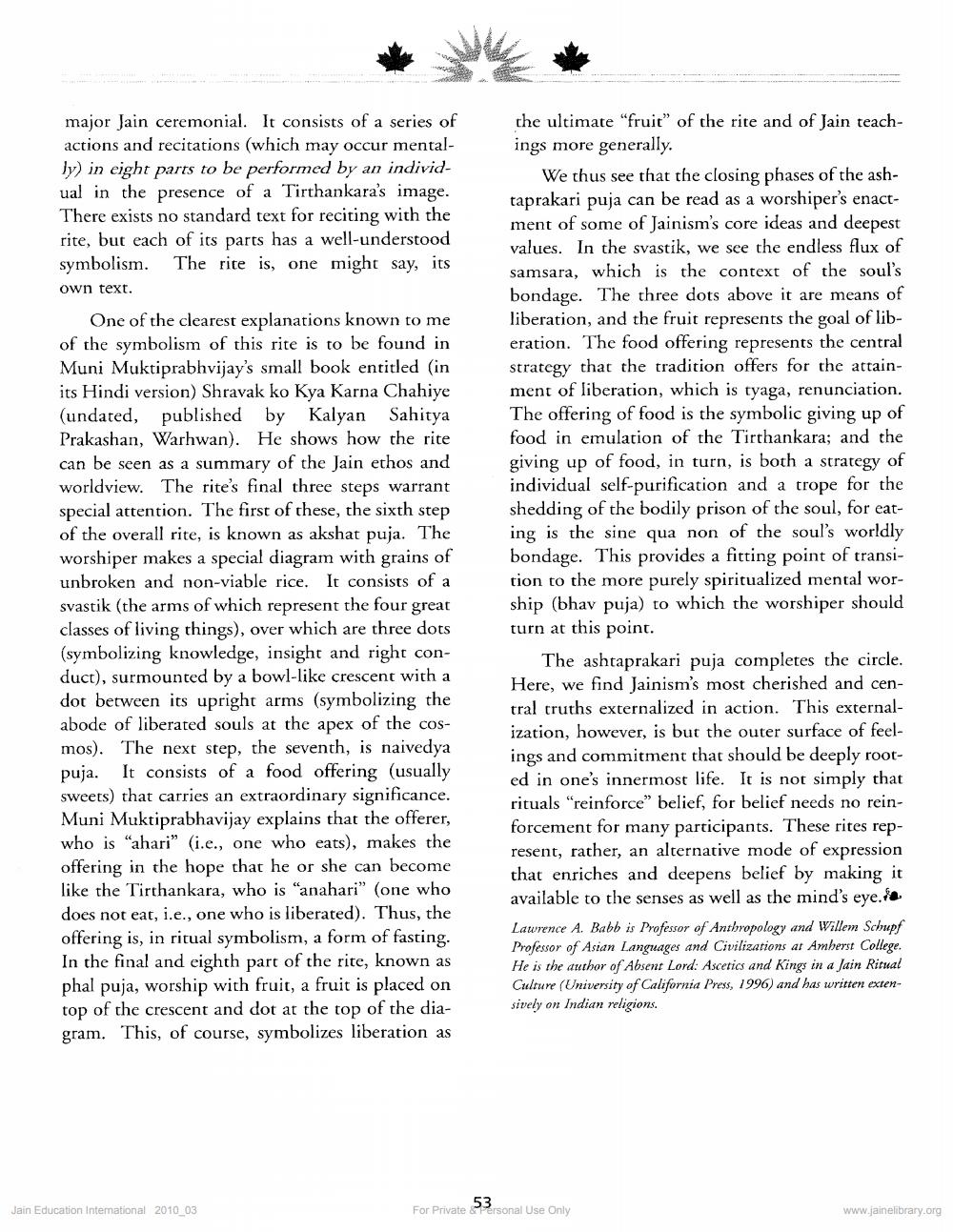________________
major Jain ceremonial. It consists of a series of actions and recitations (which may occur mentally) in eight parts to be performed by an individual in the presence of a Tirthankara’s image. There exists no standard text for reciting with the rite, but each of its parts has a well-understood symbolism. The rite is, one might say, its own text.
One of the clearest explanations known to me of the symbolism of this rite is to be found in Muni Muktiprabhvijay's small book entitled (in its Hindi version) Shravak ko Kya Karna Chahiye (undated, published by Kalyan Sahitya Prakashan, Warhwan). He shows how the rite can be seen as a summary of the Jain ethos and worldview. The rite's final three steps warrant special attention. The first of these, the sixth step of the overall rite, is known as akshat puja. The worshiper makes a special diagram with grains of unbroken and non-viable rice. It consists of a svastik (the arms of which represent the four great classes of living things), over which are three dots (symbolizing knowledge, insight and right conduct), surmounted by a bowl-like crescent with a dot between its upright arms (symbolizing the abode of liberated souls at the apex of the cosmos). The next step, the seventh, is naivedya puja. It consists of a food offering (usually sweets) that carries an extraordinary significance. Muni Muktiprabhavijay explains that the offerer, who is "ahari" (i.e., one who eats), makes the offering in the hope that he or she can become like the Tirthankara, who is "anahari” (one who does not eat, i.e., one who is liberated). Thus, the offering is, in ritual symbolism, a form of fasting. In the final and eighth part of the rite, known as phal puja, worship with fruit, a fruit is placed on top of the crescent and dot at the top of the diagram. This, of course, symbolizes liberation as
the ultimate "fruit" of the rite and of Jain teachings more generally.
We thus see that the closing phases of the ashtaprakari puja can be read as a worshiper's enactment of some of Jainism's core ideas and deepest values. In the svastik, we see the endless flux of samsara, which is the context of the soul's bondage. The three dots above it are means of liberation, and the fruit represents the goal of liberation. The food offering represents the central strategy that the tradition offers for the attainment of liberation, which is tyaga, renunciation. The offering of food is the symbolic giving up of food in emulation of the Tirthankara; and the giving up of food, in turn, is both a strategy of individual self-purification and a trope for the shedding of the bodily prison of the soul, for eating is the sine qua non of the soul's worldly bondage. This provides a fitting point of transition to the more purely spiritualized mental worship (bhav puja) to which the worshiper should turn at this point.
The ashtaprakari puja completes the circle. Here, we find Jainism's most cherished and central truths externalized in action. This externalization, however, is but the outer surface of feelings and commitment that should be deeply rooted in one's innermost life. It is not simply that rituals "reinforce" belief, for belief needs no reinforcement for many participants. These rites represent, rather, an alternative mode of expression that enriches and deepens belief by making it available to the senses as well as the mind's eye.ia Lawrence A. Babb is Professor of Anthropology and Willem Schupf Professor of Asian Languages and Civilizations at Amherst College. He is the author of Absent Lord: Ascetics and Kings in a Jain Ritual Culture (University of California Press, 1996) and has written extensively on Indian religions.
Jain Education Intemational 2010_03
For Private Personal Use Only
www.jainelibrary.org




